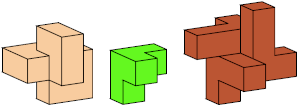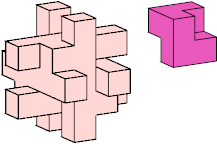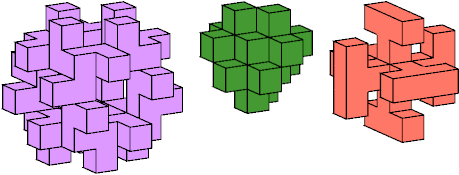
Polycube symmetries (conjugacy classes of subgroups of the achiral
octahedral group) were first identified by W. F. Lunnon in
Symmetry of Cubical and General Polyominoes,
in Graph Theory and Computing,
Ronald C. Read, editor, New York, Academic Press, 1972.
Lunnon's codes are given below.
An asterisk means that Lunnon's example differs from mine.










| 1 | 2 | 3 | 4 | 6 | 8 | 12 | 16 | 24 | 48 | ||||||||||||||||||||||||
| I5 | C4 | B6 | K6 | F5 | E4 | D7 | A12 | J10 | BC10 | BB10 | CK6 | BE4 | CE3 | BF6 | EE4 | CD10 | FF4 | H12 | AB16 | EF6 | BFF8 | CJ6 | AE8 | EFF7 | EEE6 | BD34 | CF6 | BBC2 | R56 | CCC20 | DEE25 | G1 | |
| I5 | > | > | > | > | > | > | > | > | > | > | > | > | > | > | > | > | > | > | > | > | > | > | > | > | > | > | > | > | > | > | > | > | |
| C4 | < | ∥ | ∥ | ∥ | ∥ | ∥ | ∥ | ∥ | > | ∥ | > | ∥ | > | ∥ | ∥ | ∥ | ∥ | ∥ | > | ∥ | ∥ | > | ∥ | > | ∥ | ∥ | ∥ | > | > | ∥ | ∥ | > | |
| B6 | < | ∥ | ∥ | ∥ | ∥ | ∥ | > | > | > | > | ∥ | > | ∥ | > | > | ∥ | ∥ | ∥ | > | > | > | > | > | > | > | > | ∥ | > | > | > | > | > | |
| K6 | < | ∥ | ∥ | ∥ | ∥ | ∥ | ∥ | ∥ | ∥ | ∥ | > | > | ∥ | ∥ | ∥ | ∥ | ∥ | > | ∥ | ∥ | ∥ | ∥ | > | > | > | ∥ | > | > | ∥ | ∥ | > | > | |
| F5 | < | ∥ | ∥ | ∥ | ∥ | ∥ | ∥ | ∥ | ∥ | ∥ | > | ∥ | > | > | ∥ | ∥ | > | ∥ | ∥ | > | > | ∥ | ∥ | > | ∥ | ∥ | > | > | ∥ | > | ∥ | > | |
| E4 | < | ∥ | ∥ | ∥ | ∥ | ∥ | ∥ | ∥ | ∥ | ∥ | ∥ | > | > | ∥ | > | ∥ | ∥ | ∥ | ∥ | > | ∥ | > | > | > | > | ∥ | ∥ | > | ∥ | ∥ | > | > | |
| D7 | < | ∥ | ∥ | ∥ | ∥ | ∥ | ∥ | ∥ | ∥ | ∥ | ∥ | ∥ | ∥ | ∥ | ∥ | > | > | > | ∥ | ∥ | ∥ | ∥ | ∥ | ∥ | ∥ | > | > | ∥ | > | > | > | > | |
| A12 | < | ∥ | < | ∥ | ∥ | ∥ | ∥ | ∥ | ∥ | ∥ | ∥ | ∥ | ∥ | ∥ | ∥ | ∥ | ∥ | ∥ | > | > | ∥ | ∥ | > | ∥ | ∥ | ∥ | ∥ | > | > | ∥ | ∥ | > | |
| J10 | < | ∥ | < | ∥ | ∥ | ∥ | ∥ | ∥ | ∥ | ∥ | ∥ | ∥ | ∥ | ∥ | ∥ | ∥ | ∥ | ∥ | ∥ | ∥ | > | > | > | ∥ | ∥ | ∥ | ∥ | > | ∥ | > | ∥ | > | |
| BC10 | < | < | < | ∥ | ∥ | ∥ | ∥ | ∥ | ∥ | ∥ | ∥ | ∥ | ∥ | ∥ | ∥ | ∥ | ∥ | ∥ | > | ∥ | ∥ | > | ∥ | > | ∥ | ∥ | ∥ | > | > | ∥ | ∥ | > | |
| BB10 | < | ∥ | < | ∥ | ∥ | ∥ | ∥ | ∥ | ∥ | ∥ | ∥ | ∥ | ∥ | ∥ | ∥ | ∥ | ∥ | ∥ | > | ∥ | > | ∥ | ∥ | ∥ | > | > | ∥ | > | > | > | > | > | |
| CK6 | < | < | ∥ | < | < | ∥ | ∥ | ∥ | ∥ | ∥ | ∥ | ∥ | ∥ | ∥ | ∥ | ∥ | ∥ | ∥ | ∥ | ∥ | ∥ | ∥ | ∥ | > | ∥ | ∥ | ∥ | > | ∥ | ∥ | ∥ | > | |
| BE4 | < | ∥ | < | < | ∥ | < | ∥ | ∥ | ∥ | ∥ | ∥ | ∥ | ∥ | ∥ | ∥ | ∥ | ∥ | ∥ | ∥ | ∥ | ∥ | ∥ | > | > | > | ∥ | ∥ | > | ∥ | ∥ | > | > | |
| CE3 | < | < | ∥ | ∥ | < | < | ∥ | ∥ | ∥ | ∥ | ∥ | ∥ | ∥ | ∥ | ∥ | ∥ | ∥ | ∥ | ∥ | ∥ | ∥ | ∥ | ∥ | > | ∥ | ∥ | ∥ | > | ∥ | ∥ | ∥ | > | |
| BF6 | < | ∥ | < | ∥ | < | ∥ | ∥ | ∥ | ∥ | ∥ | ∥ | ∥ | ∥ | ∥ | ∥ | ∥ | ∥ | ∥ | ∥ | > | > | ∥ | ∥ | > | ∥ | ∥ | ∥ | > | ∥ | > | ∥ | > | |
| EE4 | < | ∥ | < | ∥ | ∥ | < | ∥ | ∥ | ∥ | ∥ | ∥ | ∥ | ∥ | ∥ | ∥ | ∥ | ∥ | ∥ | ∥ | > | ∥ | > | ∥ | ∥ | > | ∥ | ∥ | > | ∥ | ∥ | > | > | |
| CD10 | < | ∥ | ∥ | ∥ | ∥ | ∥ | < | ∥ | ∥ | ∥ | ∥ | ∥ | ∥ | ∥ | ∥ | ∥ | ∥ | ∥ | ∥ | ∥ | ∥ | ∥ | ∥ | ∥ | ∥ | > | > | ∥ | > | > | > | > | |
| FF4 | < | ∥ | ∥ | ∥ | < | ∥ | < | ∥ | ∥ | ∥ | ∥ | ∥ | ∥ | ∥ | ∥ | ∥ | ∥ | ∥ | ∥ | ∥ | ∥ | ∥ | ∥ | ∥ | ∥ | ∥ | > | ∥ | ∥ | > | ∥ | > | |
| H12 | < | ∥ | ∥ | < | ∥ | ∥ | < | ∥ | ∥ | ∥ | ∥ | ∥ | ∥ | ∥ | ∥ | ∥ | ∥ | ∥ | ∥ | ∥ | ∥ | ∥ | ∥ | ∥ | ∥ | ∥ | > | ∥ | ∥ | ∥ | > | > | |
| AB16 | < | < | < | ∥ | ∥ | ∥ | ∥ | < | ∥ | < | < | ∥ | ∥ | ∥ | ∥ | ∥ | ∥ | ∥ | ∥ | ∥ | ∥ | ∥ | ∥ | ∥ | ∥ | ∥ | ∥ | > | > | ∥ | ∥ | > | |
| EF6 | < | ∥ | < | ∥ | < | < | ∥ | < | ∥ | ∥ | ∥ | ∥ | ∥ | ∥ | < | < | ∥ | ∥ | ∥ | ∥ | ∥ | ∥ | ∥ | ∥ | ∥ | ∥ | ∥ | > | ∥ | ∥ | ∥ | > | |
| BFF8 | < | ∥ | < | ∥ | < | ∥ | ∥ | ∥ | < | ∥ | < | ∥ | ∥ | ∥ | < | ∥ | ∥ | ∥ | ∥ | ∥ | ∥ | ∥ | ∥ | ∥ | ∥ | ∥ | ∥ | > | ∥ | > | ∥ | > | |
| CJ6 | < | < | < | ∥ | ∥ | < | ∥ | ∥ | < | < | ∥ | ∥ | ∥ | ∥ | ∥ | < | ∥ | ∥ | ∥ | ∥ | ∥ | ∥ | ∥ | ∥ | ∥ | ∥ | ∥ | > | ∥ | ∥ | ∥ | > | |
| AE8 | < | ∥ | < | < | ∥ | < | ∥ | < | < | ∥ | ∥ | ∥ | < | ∥ | ∥ | ∥ | ∥ | ∥ | ∥ | ∥ | ∥ | ∥ | ∥ | ∥ | ∥ | ∥ | ∥ | > | ∥ | ∥ | ∥ | > | |
| EFF7 | < | < | < | < | < | < | ∥ | ∥ | ∥ | < | ∥ | < | < | < | < | ∥ | ∥ | ∥ | ∥ | ∥ | ∥ | ∥ | ∥ | ∥ | ∥ | ∥ | ∥ | > | ∥ | ∥ | ∥ | > | |
| EEE6 | < | ∥ | < | < | ∥ | < | ∥ | ∥ | ∥ | ∥ | < | ∥ | < | ∥ | ∥ | < | ∥ | ∥ | ∥ | ∥ | ∥ | ∥ | ∥ | ∥ | ∥ | ∥ | ∥ | > | ∥ | ∥ | > | > | |
| BD34 | < | ∥ | < | ∥ | ∥ | ∥ | < | ∥ | ∥ | ∥ | < | ∥ | ∥ | ∥ | ∥ | ∥ | < | ∥ | ∥ | ∥ | ∥ | ∥ | ∥ | ∥ | ∥ | ∥ | ∥ | ∥ | > | > | > | > | |
| CF6 | < | ∥ | ∥ | < | < | ∥ | < | ∥ | ∥ | ∥ | ∥ | ∥ | ∥ | ∥ | ∥ | ∥ | < | < | < | ∥ | ∥ | ∥ | ∥ | ∥ | ∥ | ∥ | ∥ | ∥ | ∥ | ∥ | ∥ | > | |
| BBC2 | < | < | < | < | < | < | ∥ | < | < | < | < | < | < | < | < | < | ∥ | ∥ | ∥ | < | < | < | < | < | < | < | ∥ | ∥ | ∥ | ∥ | ∥ | > | |
| R56 | < | < | < | ∥ | ∥ | ∥ | < | < | ∥ | < | < | ∥ | ∥ | ∥ | ∥ | ∥ | < | ∥ | ∥ | < | ∥ | ∥ | ∥ | ∥ | ∥ | ∥ | < | ∥ | ∥ | ∥ | ∥ | > | |
| CCC20 | < | ∥ | < | ∥ | < | ∥ | < | ∥ | < | ∥ | < | ∥ | ∥ | ∥ | < | ∥ | < | < | ∥ | ∥ | ∥ | < | ∥ | ∥ | ∥ | ∥ | < | ∥ | ∥ | ∥ | ∥ | > | |
| DEE25 | < | ∥ | < | < | ∥ | < | < | ∥ | ∥ | ∥ | < | ∥ | < | ∥ | ∥ | < | < | ∥ | < | ∥ | ∥ | ∥ | ∥ | ∥ | ∥ | < | < | ∥ | ∥ | ∥ | ∥ | > | |
| G1 | < | < | < | < | < | < | < | < | < | < | < | < | < | < | < | < | < | < | < | < | < | < | < | < | < | < | < | < | < | < | < | < | |
| I5 | C4 | B6 | K6 | F5 | E4 | D7 | A12 | J10 | BC10 | BB10 | CK6 | BE4 | CE3 | BF6 | EE4 | CD10 | FF4 | H12 | AB16 | EF6 | BFF8 | CJ6 | AE8 | EFF7 | EEE6 | BD34 | CF6 | BBC2 | R56 | CCC20 | DEE25 | G1 | |
Thanks to Bob Russell for reporting errors in this page.
Last revised 2025-06-02.